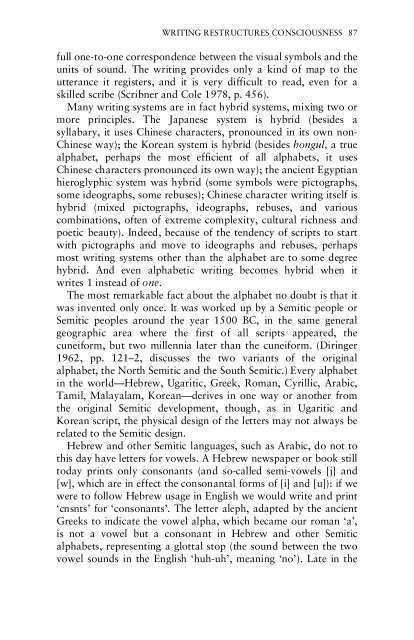Orality and Literacy: The Technologizing of the Word - Monoskop
Orality and Literacy: The Technologizing of the Word - Monoskop
Orality and Literacy: The Technologizing of the Word - Monoskop
Create successful ePaper yourself
Turn your PDF publications into a flip-book with our unique Google optimized e-Paper software.
WRITING RESTRUCTURES CONSCIOUSNESS 87<br />
full one-to-one correspondence between <strong>the</strong> visual symbols <strong>and</strong> <strong>the</strong><br />
units <strong>of</strong> sound. <strong>The</strong> writing provides only a kind <strong>of</strong> map to <strong>the</strong><br />
utterance it registers, <strong>and</strong> it is very difficult to read, even for a<br />
skilled scribe (Scribner <strong>and</strong> Cole 1978, p. 456).<br />
Many writing systems are in fact hybrid systems, mixing two or<br />
more principles. <strong>The</strong> Japanese system is hybrid (besides a<br />
syllabary, it uses Chinese characters, pronounced in its own non-<br />
Chinese way); <strong>the</strong> Korean system is hybrid (besides hongul, a true<br />
alphabet, perhaps <strong>the</strong> most efficient <strong>of</strong> all alphabets, it uses<br />
Chinese characters pronounced its own way); <strong>the</strong> ancient Egyptian<br />
hieroglyphic system was hybrid (some symbols were pictographs,<br />
some ideographs, some rebuses); Chinese character writing itself is<br />
hybrid (mixed pictographs, ideographs, rebuses, <strong>and</strong> various<br />
combinations, <strong>of</strong>ten <strong>of</strong> extreme complexity, cultural richness <strong>and</strong><br />
poetic beauty). Indeed, because <strong>of</strong> <strong>the</strong> tendency <strong>of</strong> scripts to start<br />
with pictographs <strong>and</strong> move to ideographs <strong>and</strong> rebuses, perhaps<br />
most writing systems o<strong>the</strong>r than <strong>the</strong> alphabet are to some degree<br />
hybrid. And even alphabetic writing becomes hybrid when it<br />
writes 1 instead <strong>of</strong> one.<br />
<strong>The</strong> most remarkable fact about <strong>the</strong> alphabet no doubt is that it<br />
was invented only once. It was worked up by a Semitic people or<br />
Semitic peoples around <strong>the</strong> year 1500 BC, in <strong>the</strong> same general<br />
geographic area where <strong>the</strong> first <strong>of</strong> all scripts appeared, <strong>the</strong><br />
cuneiform, but two millennia later than <strong>the</strong> cuneiform. (Diringer<br />
1962, pp. 121–2, discusses <strong>the</strong> two variants <strong>of</strong> <strong>the</strong> original<br />
alphabet, <strong>the</strong> North Semitic <strong>and</strong> <strong>the</strong> South Semitic.) Every alphabet<br />
in <strong>the</strong> world—Hebrew, Ugaritic, Greek, Roman, Cyrillic, Arabic,<br />
Tamil, Malayalam, Korean—derives in one way or ano<strong>the</strong>r from<br />
<strong>the</strong> original Semitic development, though, as in Ugaritic <strong>and</strong><br />
Korean script, <strong>the</strong> physical design <strong>of</strong> <strong>the</strong> letters may not always be<br />
related to <strong>the</strong> Semitic design.<br />
Hebrew <strong>and</strong> o<strong>the</strong>r Semitic languages, such as Arabic, do not to<br />
this day have letters for vowels. A Hebrew newspaper or book still<br />
today prints only consonants (<strong>and</strong> so-called semi-vowels [j] <strong>and</strong><br />
[w], which are in effect <strong>the</strong> consonantal forms <strong>of</strong> [i] <strong>and</strong> [u]): if we<br />
were to follow Hebrew usage in English we would write <strong>and</strong> print<br />
‘cnsnts’ for ‘consonants’. <strong>The</strong> letter aleph, adapted by <strong>the</strong> ancient<br />
Greeks to indicate <strong>the</strong> vowel alpha, which became our roman ‘a’,<br />
is not a vowel but a consonant in Hebrew <strong>and</strong> o<strong>the</strong>r Semitic<br />
alphabets, representing a glottal stop (<strong>the</strong> sound between <strong>the</strong> two<br />
vowel sounds in <strong>the</strong> English ‘huh-uh’, meaning ‘no’). Late in <strong>the</strong>

















